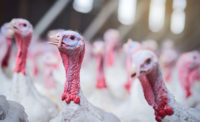Control Salmonella reading with monitoring, biosecurity and vaccines

Although it is not usually considered a threat to human health, an outbreak of Salmonella reading can cause significant food-borne illness and generate a lot of public attention. An outbreak that occurred in 2019, for example, was linked to contaminated ground turkey products, causing 358 reported illnesses, 133 hospitalizations and one death across 42 states.1
According to Sandy Aehle, a research scientist at Elanco Animal Health, managing and mitigating S. Reading requires consistent monitoring and testing to identify sources of infection in live poultry production.
“Turkey producers should monitor their facilities and flocks at least quarterly to identify if S. Reading and other pathogenic Salmonella are present,” says Aehle. “Taking a targeted approach to reducing infection in the integrated farm continuum is important. Mitigation strategies must address both vertical and horizontal transmission of Salmonella.”
Aehle suggests that producers with breeder programs walk their barns monthly with boot swabs and to have those swabs analyzed by a lab to determine the facility’s Salmonella profile. This provides a proactive approach to identifying target farms that have Salmonella profiles that could pose a significant challenge to the production system.
Another effective management strategy is to collect samples from hatch trays to identify pathogenic Salmonella that has been transferred from the hens to the poults.
Improve Biosecurity
Anything with legs can carry S. reading into a barn, including, but not limited to humans, beetles, flies and rodents. Therefore, appropriate biosecurity measures are important for reducing the prevalence of Salmonella in the barn.
“Poultry barns should have anterooms where producers, service techs and visitors can put on dedicated coveralls and over-boots as they enter the barn,” says Aehle. “These should be removed and appropriately disposed of prior to leaving the barn.”
These and other on-farm practices have been shown to effectively reduce the risk of carrying S. reading and other Salmonella pathogens from one barn to another.
Prevent Salmonella reading with Vaccines
In addition to regularly monitoring barns and improving biosecurity, turkey producers can also manage S. reading with an effective vaccination program. Aehle says active vaccines, like AviPro Megan Egg, as well as inactive vaccines, like Elanco’s custom-blended autogenous vaccines, build immunity and reduce S. reading and other Salmonella infections.
In 2018, Elanco partnered with a turkey producer to study the efficacy of Salmonella vaccines by assessing ground turkey samples for the presence of Salmonella, including S. reading. The study involved evaluating Salmonella presence in ground turkey samples before and after a vaccination program began.
A total of 557 ground turkey samples were collected between August 8, 2018 and May 31, 2019 to test the prevalence of Salmonella during the pre-vaccination period, in the vaccination transition period, and in the post-vaccination period. Overall, Salmonella prevalence was reduced by approximately 35% in the samples tested during the post-vaccination period, and the prevalence of S. reading was reduced by approximately 57%.2
Simply put, AviPro Megan Egg is robust in its ability to stimulate immunity and provide protection against Salmonella infections in a turkey production environment when compared to other vaccines.3
Turkey producers can contact their Elanco technical consultant to learn more about how Salmonella vaccinations can improve food safety in their operations.
The label contains complete use information, including cautions and warnings. Always read, understand and follow the label and use directions.
1 CDC Investigation Notice: Salmonella Outbreak Linked to Raw Turkey Products
https://www.cdc.gov/media/releases/2019/s-0215-salmonella-outbreak-raw-turkey.html
2 Elanco Animal Health. Data on file.
3 Wooming, B., M. Morgan and N. Pumford. “Comparison of two Salmonella vaccines in commercial tom turkeys.” Proceedings of the American Association of Avian Pathologists Symposium & Scientific Program, July 11-14, 2015, Boston MA
Looking for a reprint of this article?
From high-res PDFs to custom plaques, order your copy today!





